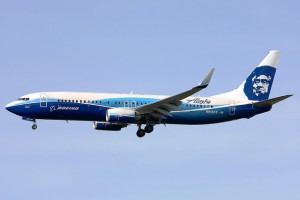
Alaska Airlines 737-800 with special Boeing livery (N512AS)
Alaska Airlines, Boeing, Portland International Airport, Seattle-Tacoma International Airport, Spokane International Airport and Washington State University are working together to promote aviation biofuel development in the Pacific Northwest. The regional assessment is called the Sustainable Aviation Fuels Northwest (SAFN).
The group hopes to examine all phases of developing an aviation biofuel industry and the funding is being split between the involved parties. SAFN will be looking at local biomass sources that can be found in the Pacific Northwest.
“By transitioning to a more fuel-efficient fleet and adopting technology to follow more direct flight paths, Alaska Airlines has made significant strides in minimizing the environmental impact of our flying in the communities we serve,” said Alaska Air Group Chairman and CEO Bill Ayer. “Through this initiative, we are joining other key stakeholders in our region to explore the development of alternatives to jet fuel that could further reduce our carbon footprint.”
The project is starting this month and is expected to take about six months. Air travel currently generates approximately 2 percent of man-made carbon emissions, and the industry has set aggressive goals to lower its carbon footprint, which includes the use of aviation biofuel when it becomes available.
This is only one of several regional biofuel projects that Boeing is currently working with. Curious to find out what Boeing hopes to achieve in this project, I spoke with Terrance Scott, who is with Boeing Environmental Communications. He explained there are four ways to help airlines curb their carbon emissions. The first is product development, where Boeing creates new, more fuel efficient aircraft, like the Boeing 787 and the Boeing 747-8. The second is to retrofit currently flying aircraft with performance packages, winglets and other items. Third is to change the way airlines fly and operate aircraft in order to be more efficient. The last way is the type of fuel used to power the aircraft.
Boeing has helped or will be helping to set up similar regional groups in the Middle East, China, Australia and Mexico. The hope is to create a regional portfolio of fuel sources to create aviation biofuel. Scott told me that Boeing wants to motivate people to find answers, but is not looking to get into the biofuels business themselves. “Boeing doesn’t want to get into the fuel business, but we want to serve as a catalyst.” Their plan is to bring people together, to start talking and working on creating sources for biofuel.
The use of biofuels have already been successfully tested. Boeing has worked with Air New Zealand and Continental to show airlines can successfully use biofuels. Now that biofuel has been proven to be a good alternative to legacy jet fuel, the shift is being made to find a sustainable, economically feasible fuel source. They want to make sure that a fuel source won’t compete with any food source (ie corn and E85).
Most likely any biofuel will cost more than jetfuel today. Would passengers be willing to pay a little bit more to fly green? I think there are some that would, but I am not sure if there would be enough.
http://safug.org/
Image: Axel J
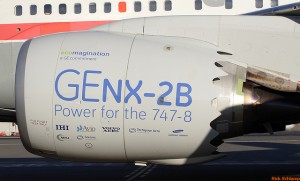
GE's Boeing 747-100 testbed with GEnx engine (N747GE)
A while back to celebrate the Boeing 787 Dreamliner’s test flights, I posted Ten Interesting Facts about the Rolls-Royce Trent 1000 Engines. Now that Boeing 787 ZA005 with GEnx engines are flying as well, I find it only fair to give 10 interesting facts about them:
#1 GE estimates the GEnx engines projected to be sold in the next 20 years will emit an about 77 million fewer tons of greenhouse gases than older comparable engines.
#2 The GEnx engine will remain on wing 30 percent longer and is 30% quieter than comparable engines in service today.
#3 The GEnx-1B for the Boeing 787 Dreamliner has a fan diameter of 111 inches and the GEnx-2B version for the Boeing 747-8 has a fan diameter of 105 inches.
#4 The GEnx engine has 18 fan blades, which is about half as many as GE’s CF6 engine.
#5 If an airline were to replace 20 of 200-to 300-passenger aircraft with next-generation jets powered by GEnx engines, it would save nearly $37 million in fuel costs annually, based on jet fuel costs of $2.50 per gallon.
#6 The GEnx engine has one of the highest pressure ratios ’“ 23:1 that sets the high pressure compressor apart from other engines.
#7 By using GEnx engines, that same fleet could save nearly 500 million gallons of jet fuel each year. Enough to fly more than 12 million people from New York City to London on Boeing 787 Dreamliner jets.
#8 The GEnx engine is the only choice on the Boeing 747-8 and is one of two choices on the Boeing 787.
#9 The engine has composite fan blades with titanium leading edges.
#10 The GEnx has a fan bypass ratio of 19:2, which also helps reduce noise.
Other cool stuff:
* Interactive page on the GEnx Engines
* Videos on the engine
* Video & pictures of Boeing 787 ZA005 with GEnx engines, first flight
Image: Rick Schlamp
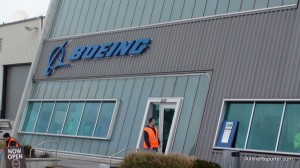
Boeing facility at Paine Field. Photo taken by me during my Boeing 787 interior tour.
When the Boeing’s 787 Dreamliner first took flight back in December 2009, there were those who questioned if Boeing really missed out on a customer relations opportunity.
Yes, Boeing had a live video feed on the internet and posted some wonderful photos and videos on their special newairplane.com website, but it still left some wanting more. People questioned why weren’t they on Twitter? Why didn’t they provide more for those that love Boeing? I somewhat agreed and felt that Boeing was making an effort, but was still distant from their fan base.
However, I think things are changing.
I have always been a frequent visitor to boeing.com, however I have been very impressed with their newer website newairplane.com. It isn’t just dry information that airlines or engineers might be interested in, but something that can really build passion for the Boeing brand. You can check out what new liveries will be on the Boeing 787 Dreamliner, take a virtual tour of both the Boeing 787 or the Boeing 747, find lots of great multimedia, and much more. It looks like I am not the only fan. Bernard Choi, with Boeing Communications, tells me that newairplane.com gets about 5-6million page views each month. That alone is a great indication, people want a closer relationship to Boeing.

Boeing facility at Paine Field where the Boeing 767, 777, 747 and 787 are made.
Boeing has also stepped into the world of Twitter. They now have three accounts: @BoeingAirplanes, @BoeingCorporate, and @BoeingDefense. And really, they are doing an outstanding job, especially only being on it for about two weeks. This week, they had their first real test of social media and I think they passed.
John Windsor, who specializes in marketing and advertisement, blogged that his son sent a photo to Boeing of a new airplane with a pretty cold response. Boeing sent a canned reply stating they do not take any outside ideas and have destroyed his son’s information. Of course this is a form letter sent to anyone who submits an idea and they didn’t have a specialized form letter to reply to a child. Honestly, it made Boeing look like it has no compassion.
A few people Tweeted the blog and it got to Boeing. Boeing Tweeted, “The letter Mr. Winsor posted is, as he said, a required response. For kids, we can do better. We’ll work on it.” Cool. They could have defended their actions, but admit that it was not appropriate and they want to improve the way they do things.
Also, Boeing Corporate Communications director Todd Blecher, also made a comment on Mr. Windsor’s blog:
“Mr. Winsor…I think I can address your comments. As you state, we have to respond to the thousands of unsolicited ideas we receive in a way that protects us against possible infringement claims. Having said that, we can do better when the idea clearly comes from a child as enthusiastic as your son. We will work on this. I hope Harry remains fascinated by airplanes and grows up to be an airplane designer. To help him and others like him we maintain the following website. I hope he enjoys it.”

The Boeing 747-8 during taxi testing at Paine Field before its first flight.
To me, that is quite awesome. He made his comment right after I made mine and I like to think I am quite quick. With all the changes and this Twitter incident, I started to wonder if Boeing was trying to directly interact with customers more than they have in the past.
I decided to try and find out. I wrote to a few folks at Boeing and heard back from Todd Blecher (remember he is the Boeing Corporate Communications director that made the blog comment) very quickly. I asked if Boeing was consciously making an effort to connect better and how they were going to respond to Mr. Winsor’s son, Harry.
Blecher assured me that Boeing will be sending Harry some items and he actually spoke with him on the phone, thanking him for his drawing and he hopes when Harry grows up, he will design airplanes for Boeing.
He also confirmed my hunches that Boeing is making a real effort here. “We spent much of the past 12 months developing and now executing an approach to online communications that makes sense for Boeing and our audiences. We figured out what we could bring to the table and how we would be willing to engage. We drew inspiration from many areas, including Randy’s Journal, newairplane.com, our corporate advertising, and other organizations.”
They realize they are new to this game and the transition won’t happen overnight. “We are learning as we go but I have no doubt that are on a journey that will see us really change the way Boeing communicates…the bottom line is we’re changing.” When I asked Blecher about their future plans he told me they are looking at Facebook, thinking about a future mobile app and possibly even a Boeing TweetUp (where people on Twitter get together, ie Aviation Geekfest). Boeing talking about a TweetUp? That’s amazing.
Blecher realizes they might not make everyone happy. “Not everybody in our audiences will like our approach. But, to paraphrase Sinatra, we’re doing it our way because to try it any other way, to expect an organizational mindset to change overnight, is a sure way to set yourself up for a lot of frustration and aggravation and mistakes.” Even if they might make a few mistakes and frustrate a few people, I think it will be worth it in the long-run.
Who knows, if Boeing can really build that brand loyalty, maybe more people will be saying, “If it ain’t Boeing, I ain’t Going!”
connect | web | twitter | facebook |
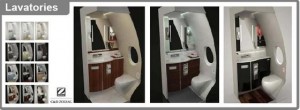
Some of the Airbus A350 lavatory options. Click the link to RunwayGirl's blog for larger version.
Now that the Boeing 787 and Boeing 747-8 have taken their first flights, attention is starting to move towards watching the new Airbus A350. Mary Kirby, over on her blog RunwayGirl, is posting a glimpse of the interior of the new Airbus A350.
Airbus has been working on the Aircraft Description Document, defining what interior options will be available. With the A350, Airbus hopes to increase flexibility in cabin layout, without having to change the structure of the aircraft.
The Airbus A350 is Airbus’ answer to the Boeing 787 (and partially to the B777). Like the Boeing 787, it will be made primarily of carbon fiber and be more fuel efficient compared to previous aircraft types. Currently the A350-900XWB is expected to carry more passengers and fly farther than the Boeing 787-8. The first flight is currently scheduled for 2012, with delivery scheduled for 2013.
Check our RunwayGirl’s blog for more photos and information on the Airbus A350 interior.
And if you are on Twitter, we made #A350XWP the official hashtag for the Airbus A350 (if that makes no sense to you, don’t worry about it).
connect | web | twitter | facebook |
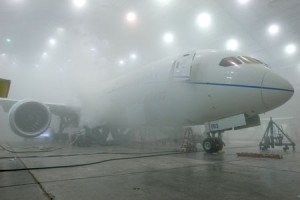
The Boeing 787 Dreamliner (ZA003) undergoing cold weather testing in McKinley Climatic Laboratory, Florida
If you have been following the path of the Boeing 787, you know that ZA003 recently made a trip down to Valparaiso, Florida for extreme weather testing. Being in Florida you might assume they are testing the Boeing 787 Dreamliner in just hot and humid climates.
However it just recently went through extreme cold testing of minus 45 degrees Fahrenheit (that is about minus 43 Celsius). How do does this happen? Well, you find a big facility that can create it’s own temperature (and snow). Eglin Air Force Base, just outside of Ft. Walton Beach, has a climatic chamber, large enough to house the Boeing 787. In the mid-1990’s, the chamber was opened up to the general public at a cost of $20,000 to $30,000 per day.
Normally Boeing chaces the cold weather around the globe (normally finding it in Fairbanks, Alaska), but having a controlled environment is so much easier. “Here we say minus 45 and they set the knob to minus 45, and work their magic and get minus 45 and it stays there as long as we want it,” Tom Sanderson, one of the flight test directors for the Boeing 787 told Glenn Farley with KING5.
The Boeing 787 will also undergo extreme hot testing of 115 degrees Fahrenheit (about 46 degrees Celsius) in the same facility. ZA003 is the only Dreamliner with a partial interior. The aircraft will be living at the facility for about two weeks to conduct all the testing needed.
I am sure you want to see more than one photo, luckily I have tracked down some additional media for your enjoyment:
* Video done by Glenn Farley with KING5.
* Video taken by Jon Ostrower via his blog FlightBlogger.
* Video taken by Boeing, found via Seattle PI.
Image: Boeing
connect | web | twitter | facebook |






